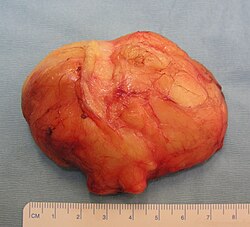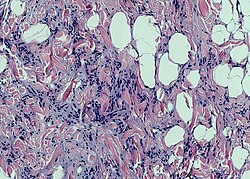Lipoma
Lipoma is a benign tumor ussualy with an origin in subcutaneous adipose tissue. It is a common mesenchymal benign tumor. The peak incidence is between the ages of 40 and 60, they are more common in men. A higher incidence of lipomas is observed in obese patients The same tumor from brown adipose tissue is called hibernoma.
Macroscopic appearance[edit | edit source]
Lipoma is sharply demarcated, but is bounded only by a fine sheath. It has a soft pasty or flexible consistency. It has a yellow color on the cut. The most common localisation is subcutaneous connective tissue.It is characteristic of subcutaneous lipomas that as adipose tissue increases, the volume of lipoma increases in the same way as the volume of healthy adipose tissue. Only with weight loss and fat loss is there a clear difference; lipoma does not release fat and thus does not significantly decrease during weight loss. Due to its location, the initially imperceptible lipoma can become obvious due to rapid weight loss in a relatively short time.
However, lipomas can also form in the deeper structures of connective tissue, typically in skeletal muscle. According to the relationship of lipoma to muscle, we can then speak of intramuscular and intermuscular lipomas. Intramuscular lipoma grows inside one muscle, while intermuscular lipoma grows more in the space between individual muscles.
Another localization in which lipomas can be expected more frequently is the gastrointestinal tract. Gastrointestinal lipomas most often grow from the submucosa of the small and large intestine, they can quite often appear on the omentum.
Lipoma mimics the presence of adipose tissue, but it can also occur in regions where the occurrence of adipose tissue is unusual. In the case of such an unusual occurrence, for example in the brain or pleura we speak of heterogeneous lipoma.
Pendulum (penduling) lipoma[edit | edit source]
If the lipoma grows from the free surface and is attached only by the stem, we speak of a penduling lipoma. Pendulum lipoma is nourished exclusively by the stalk; if nutrition becomes insufficient, eg due to torsion or strangulation, regressive changes occur in the lipoma. Partial necrosis creates cavities filled with fat called oily pseudocysts. Minor regressions can secondary calcify, the resulting condition is called lipoma ossificans.
Histological structure[edit | edit source]
Histologically, the lipoma consists of mature unilocular adipocytes, between which smaller cells with smaller fat vacuoles are scattered. These smaller cells gather mainly around the blood vessels and represent the proliferation zone of the tumor, i.e. the zone from which the lipoma grows.
Histological subtypes[edit | edit source]
Spindle cell lipoma[edit | edit source]
A special histological variant is benign spindle cell lipoma. It consists of an admixture of spindle cells embedded in a myxoid (= mucous) matrix. It occurs mainly in the elderly in the shoulder area.
Proliferating lipoma[edit | edit source]
Another variant with a slightly different behavior is proliferating lipoma (invasive lipoma). This type of lipoma is characterized by more intense growth, which prevents tumor cells from accumulating the usual amount of lipids. Tumor cells are smaller, with numerous relatively small fat vacuoles in their cytoplasm. These fat vacuoles mechanically deform the core. Mucus is relatively often deposited in the interstitium of a proliferating lipoma.
Angiolipoma[edit | edit source]
The vascular component of a tumor can sometimes be significantly enlarged, such a tumor is called angiolipoma. mall caliber vessels in angiolipoma can trombose quite often, resulting in secondary regression changes.
Clinical picture[edit | edit source]
Clinically, lipoma manifests as painless lesions between 1 and 25 cm in size. In particular, deeper lesions can more easily be overlooked and thus becomming larger.
In about 5 to 15% of cases, multiple lipomas occur and they may be associated with some syndromes. These are mainly the following syndromes:
- Bannayan's Zonan's syndrome
- Cowden's syndrome
- Fröhlich's syndrome
- Proteus syndrome
Diagnosis[edit | edit source]
Diagnosis is usually not a problem, the microscopic image is quite characteristic. Thus, lipoma is usually well distinguishable from well-differentiated liposarcoma and lipoma-like lesions. In the case of intramuscular lipomas, we may sometimes need to distinguish lipoma from intramuscular hemangioma.
Findings in medical imaging methods[edit | edit source]
In the native X-ray image, the lipoma appears to be a low-density region, and calcifications may be present in approximately one-tenth of cases. In CT it appears as a tissue with fat-like properties, the density is usually between -65 and -120 HU. MR is a modality that is not only able to confirm the diagnosis, but can also point out the risk of liposarcoma. Sonographic examination shows soft echogenic matter.
Therapy[edit | edit source]
As a completely benign tumor simple excision is in most cases a curative procedure. However, if lipoma does not cause problems, it is not necessary.
The situation with some intramuscular lipomas may be less favorable. These tend to have local recurrences, which can only be prevented by removing the entire affected muscle.
Links[edit | edit source]
Related articles[edit | edit source]
Resources[edit | edit source]
- BEDNÁŘ, Blahoslav, et al. Pathology : Svazek 1. 2. edition. Avicenum, 1982.
- FOLPE, Andrew L. – INWARDS, Carrie Y., et al. Bone and Soft Tissue Pathology. 1. edition. Saunders, 2010. ISBN 978-0-443-06688-7.
- PASTOR, Jan. Langenbeck's medical web page: Nádory [online]. ©2006. [cit. 2010-04-18]. <https://www.freewebs.com/langenbeck/Nadory.rar>.
- Radiopaedia.org. Lipoma [online]. [cit. 2010-12-08]. <https://radiopaedia.org/articles/lipoma>.
External links[edit | edit source]
- Angiolipoma - clear YouTube video in English with subtitles
- KROUPA, Radek – DOLINA, Jiří. , et al. Lipom tenkého střeva jako neobvyklá příčina krvácení do trávicího traktu. Interní medicína pro praxi [online]. 2002, y. 4, vol. 11, p. 557-559, Available from <http://www.solen.cz/pdfs/int/2002/11/08.pdf>. ISSN 1803-5256.
- NOVÁK, Zdeněk – CHRASTINA, Jan, et al. CNS lipomas and their neuroendoscopic treatment [online] . In -. XXIX. Brněnské onkologické dny. 1. edition. 2005. Available from <https://www.linkos.cz/odbornici/kongresy/abstrakta_vypis.php/?ID=422>.







